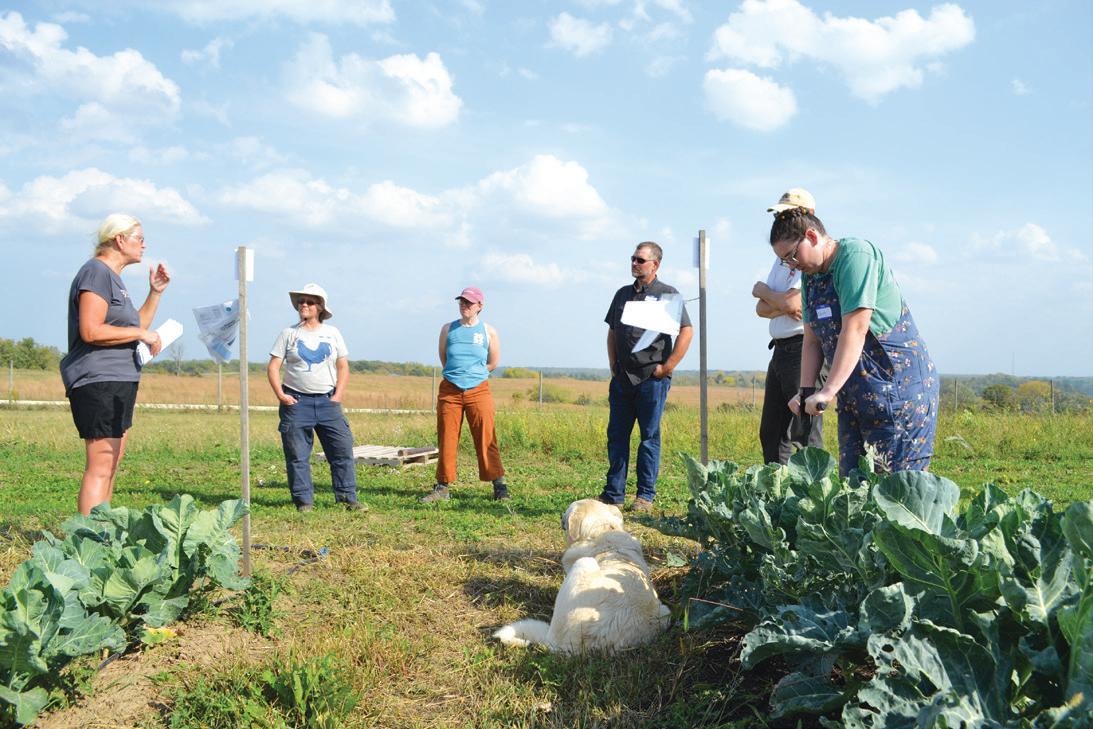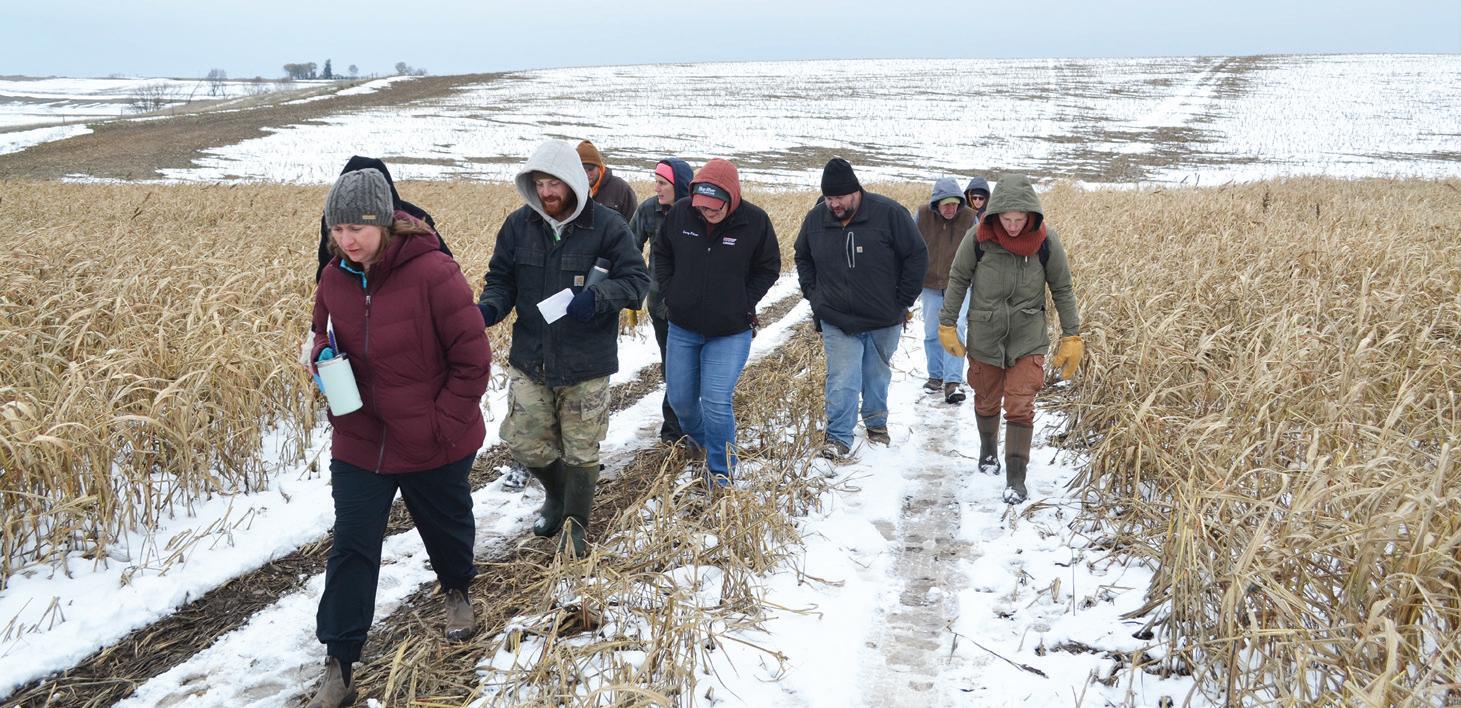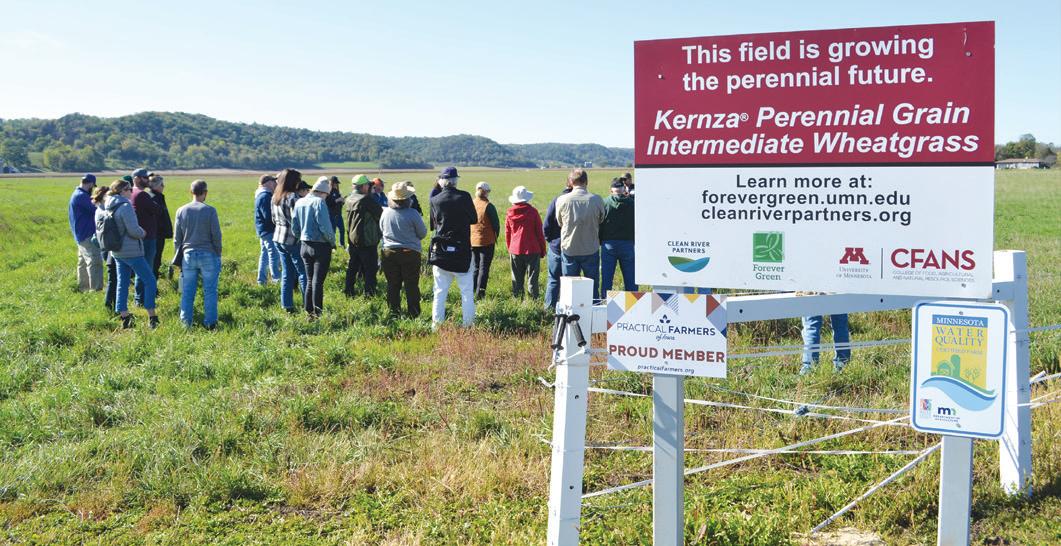
6 minute read
Soil Health
…Summer, from page 19 perhaps it’s not surprising that taking care of the land was a priority for Sandy and Lonny Dietz when they started raising vegetables a few miles from the Beaver townsite in 1996. Before they bought the farm, its soil had suffered as a result of intense corn and soybean cropping practices and lack of good biological activity. In fact, the soil was so poor they had difficulty growing anything at first.
“There was no topsoil left — it was down to subsoil,” Sandy recalled.
Advertisement
Over the years, the farmers have used mulching and cover crops to build back their soil’s organic matter. However, one thing that always concerned the Dietzes was how much their organic vegetable production system relies heavily on tillage to control weeds. Such constant disturbance can be bad news not only when it comes to erosion, but also in terms of the soil’s microbial health and its aggregate structure.
As a result, the Dietzes’ Whitewater Gardens Farm has gotten funding from the USDA’s Sustainable Agriculture Research and Education initiative to study three different kinds of no-till vegetable production methods: deep compost mulch, hay and straw mulch, and a living cover crop of clover. During a field day on an unseasonably warm day in October, the farmers showed participants what they are testing and shared some preliminary results.
The jury is still out on which method works best to prevent erosion. And covering the soil isn’t the farmers’ only goal — through this research, the Dietzes are also focused on developing a system that goes beyond the surface and builds soil biology, creating fields that are resilient long into the future. One thing they’ve learned over the past three decades is that keeping soil in place is not enough — it’s also critical to make sure there is good biological activity taking place underfoot. So the farmers are integrating extensive soil testing into the study to measure what impact various no-till systems have on the biome.
“It’s kind of cliché saying you’re working with nature or mimicking nature, but you do have to see what nature is doing,” said Sandy. “You have to get the other legs of the stool involved.” u
Grazing Cover Crops Season Stretcher
The first snow of the season had just fallen when Alan Bedtka hosted an LSP field day on his farm near Dover in southeastern Minnesota. That was fitting, given that the subject at hand was how to set up a system where cattle can graze deep into the winter. A stand of tall sorghum-sudangrass was rattling in the harsh wind as Bedtka described how he uses annual crops that are planted during the summer as a source of low-cost forage once the snow is deep. Those rangy stalks poke up through deep snow drifts, allowing the cattle to graze in the field well into the cold season.

Bedtka has been rotationally grazing cover crops for around four years, and said it’s helping him reach his goals of creating a profitable and efficient cow-calf enterprise. His soil health is improving and water infiltration has increased. Bedtka has also been able to cut his reliance on purchased fertilizers on the corn, soybeans, and sweet corn acres his family raises. The covers take pressure off his permanent pastures, which was especially important during a drought year like 2023. Bedtka has made use of various government programs to help further establish his cover cropping and grazing system, including the Olmsted County Groundwater Protection and Soil Health Program (see page 22).
The farmer is a self-described “numbers guy,” so while standing near a stand of sorghum-sudangrass he cited figures from a clipboard he held showing the various seeding and fencing costs associated with his system, as well as the returns. The bottom line: Bedtka is making more money than when he was using a total mix ration (TMR) system to haul feed to the cattle.
And by growing a tall cover crop like sorghum-sudangrass, he is also able to extend not only how many acres he grazes, but how long those acres are actually providing forage to his 52-head cow-calf herd. The 35-year-old has been supporting himself working as a carpenter, and being able to extend the grazing season as long as possible helps make being on the farm fulltime a realistic possibility. Bedtka’s goal is a 300-day grazing season, and he’s come tantalizingly close to that — 285 days out in the paddocks was his best year thus far. Each day a cow is on the land means fewer days on an off-farm job site for the young farmer.
“I traded my TMR for a no-till drill,” he said. “Every day you feed hay, you go backwards. Any day you can graze is better.” u
Summer, see page 21…
“It can be done,” said Alan Kraus of the Tentis family’s work to build a farming operation based on healthy soil. (LSP Photo)
…Summer, from page 20
A Peek at the Future Ag’s Public Good
When Matt and Seth Tentis began taking over their family’s farm in southeastern Minnesota’s Wabasha County in 2016, they almost immediately began utilizing soil health practices such as no-till, minimum till, cover cropping, and diverse rotations. They both work fulltime off the farm, and Matt is in the National Guard, so efficient use of time and resources is a key goal for the brothers. A critical component of that transition has been reintegrating livestock onto the farm. The operation has been in the family since 1938, and over the decades has been home to hogs, dairy cows, even turkeys. But starting in 2003, animals were pretty much replaced with row crops.
Utilizing financial and technical support from the USDA’s Environmental Quality Incentives Program (EQIP), Matt and Seth established a rotational grazing infrastructure on tabletop-flat acres that were formerly row-cropped. Erecting fence around open crop fields raised eyebrows in the neighborhood, especially since a previous generation had worked hard to tear fenceposts out.
“If you grow anything but corn and soybeans here, you’re definitely an outlier,” said Matt. “For us, it worked better to have a certain amount of cropping land mixed with pasture and have the cattle doing the work.”
Today, the Tentises have a 50-cow herd that serves as the basis of their White Barn Acres direct-to-consumer beef enterprise. They also raise sweet corn for a local cannery, as well as soybeans. In addition, in recent years they’ve experimented with growing camelina, which is an oilseed, and Kernza, which is the world’s first commercially viable perennial grain.
White Barn Acres is less than two miles from the Mississippi River, and lies in the heart of southeastern Minnesota’s fragile and porous karst geological area. That means building a farm business that is based on good soil health not only benefits two brothers looking for ways to make their operation efficient — it also provides a public good in the form of a reduced reliance on chemical inputs that can contaminate groundwater.
Besides EQIP, the Tentises have used several other government and university programs to put in place soil-friendly practices. During an October field day sponsored by LSP and Clean River Partners, among others, the family described how support from groups like the Land Stewardship Project and research projects like the University of Minnesota’s Forever Green initiative have helped them not only get their practices established, but provided them an opportunity to take a chance on experimentation involving something like a perennial grain.
Because of the practices the brothers use, White Barn Acres is a Minnesota Agricultural Water Quality Certified Farm, which means it qualifies for specially designated technical and financial assistance to implement practices that promote water quality, among other things. Toward the end of the field day, participants walked up the farm’s driveway — on one side was a soybean field that had been no-tilled and on the other a cover cropped field planted to a cocktail mix and awaiting fall grazing. The group stopped
Give it a Listen
Join LSP’s Soil Builders’ Network
Interested in profitable ways to build soil health? Join hundreds of other like-minded farmers, natural resource professionals, and others in the Upper Midwest and become a member of the Land Stewardship Project’s Soil Builders’ Network. Members get regular updates on workshops, field days, and on-farm demonstrations, as well as the latest soil health and cover crop research.
For more information on joining, see landstewardshipproject.org/soil-health or contact LSP’s Alex Romano (aromano@ landstewardshipproject.org, 612-7679880) or LSP’s Maura Curry (mcurry@ landstewardshipproject.org, 612-7679882).
at the end of the driveway to check out a thriving stand of Kernza. Across the road, a neighbor’s field was already plowed black on this day in mid-October.
Alan Kraus, the conservation program manager for Clean River Partners, addressed the crowd as they stood in the Kernza. He pointed out that they had just walked through the kind of farming landscape that should represent the regenerative future of agriculture.

“It can be done — farmers like Matt and Seth are proving it,” he said. “And that plowed field across the road — that’s what we don’t want for the future.” p
On LSP’s Ear to the Ground podcast, hear the folks quoted in this article discuss some of the issues they grapple with when building soil health profitably. The podcasts are on the Ear Dirt web page: landstewardshipproject.org/ear-dirt.
3 Episode 325: Return of the Fence (Matt Tentis)
3 Episode 324: Good Grass Makes Good Neighbors (Jeremy Holst)
3 Episode 323: Rainy Day Fund (Nathan Vergin)
3 Episode 321: Buried Knowledge (Sandy & Lonny Dietz)
3 Episode 320: Season Stretcher (Alan Bedtka)
3 Episode 318: Great Expectations (Mike Seifert)
3 Episode 316: Passing on Purity (David Kleinschmidt)
3 Episode 314: Going for the Goat (Jordan Meyer)
3 Episode 313: Walking & Talking (Nikki Meyer)
3 Episode 312: Testing in Nature’s Image (Liz Haney)








